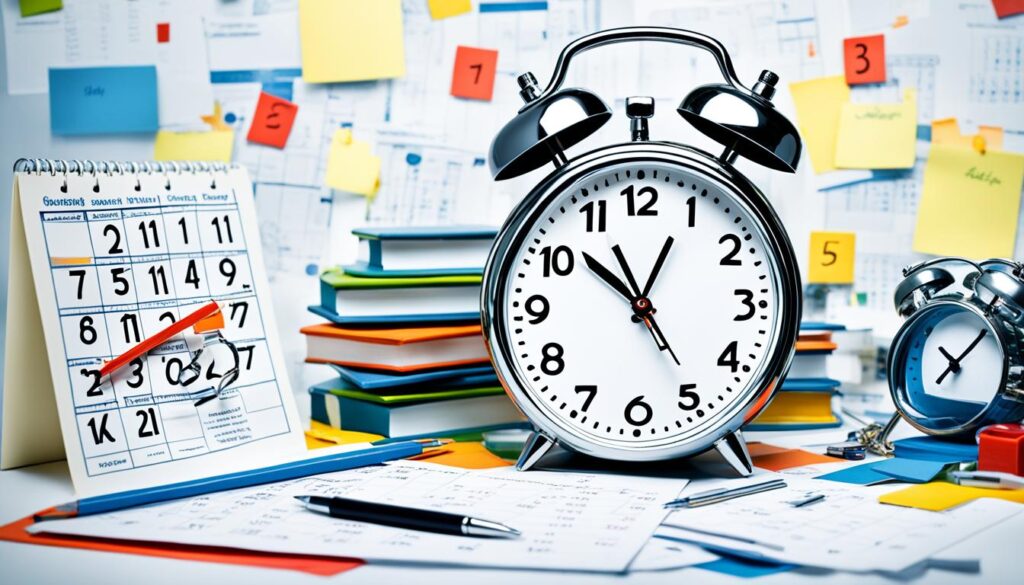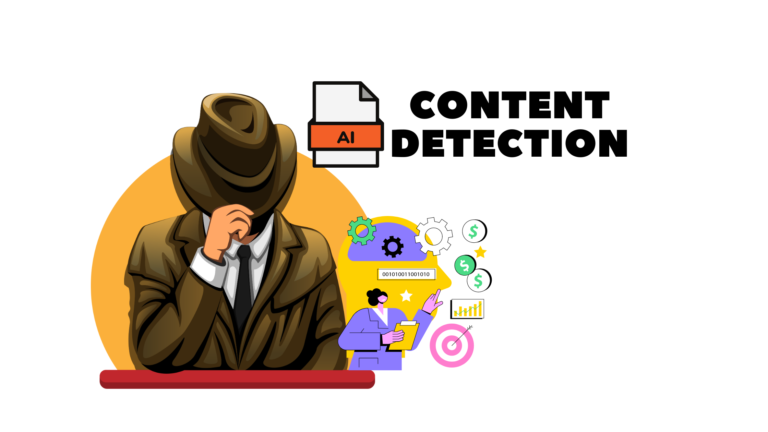How to Stop Wasting Time: Get Things Done Effectively
“The bad news is time flies. The good news is you’re the pilot.” – Michael Altshuler
In today’s fast world, time is very valuable. We often get overwhelmed by many tasks and commitments. But, there are ways to stop wasting time and get things done.
Welcome to this guide on managing time and being more productive. I’ll share tips and techniques to help you control your time. You’ll learn how to do more efficiently and reach your goals.
Key Takeaways:
- Time is a valuable resource, and it’s up to us to make the most of it.
- The key to effective time management is being proactive and taking control of your schedule.
- By setting clear goals and priorities, you can focus your efforts on what truly matters.
- Overcoming procrastination and eliminating time wasters are crucial steps in optimizing your productivity.
- Creating a productive environment and managing your energy levels can significantly impact your performance.
Mastering Time Management
Time management is key to getting things done well and fast. It helps you work better and reach your goals easily. By learning how to manage your time well, you can do more with less effort.
To manage your time well, start by picking tasks that need to be done first. This helps you focus on what’s really important. It keeps you from wasting time on things that don’t matter.
The time blocking method is a great way to stay on track. It means setting aside certain times for different tasks. This keeps your day organized and makes sure you spend enough time on each job.
It’s also important to know what wastes your time. These are things that take up time but don’t help you get things done. Cutting out these time wasters can make you more efficient and give you more time for important tasks.
Having a clean and organized workspace helps you manage tasks better. A tidy space means less distraction and more focus. This makes you more productive.
Good time management isn’t just about doing more in less time. It’s about working smart and setting clear goals. It’s about doing things that help you reach your big goals.
Benefits of Effective Time Management
Learning to manage your time well has big benefits for your life and work:
- Increased productivity: You can do more tasks in less time, making you work more efficiently.
- Reduced stress levels: Being organized and avoiding last-minute stress makes you feel calmer.
- Better work-life balance: You can set aside time for work, fun, and personal stuff, leading to a better balance.
- Improved decision-making: Knowing what’s important and how you spend your time helps you make smarter choices about what to do next.
Using good time management tips and tricks can help you control your schedule. It makes you more productive and successful in all parts of your life.

Setting Clear Goals
Setting clear goals is key to managing tasks well. Knowing what you want helps you plan and stay focused. This makes reaching your goals easier.
Here are steps to set goals effectively:
- Define Your Objectives: Start by clearly defining what you want to do. Make your goals specific and measurable. This keeps you motivated and lets you track your progress.
- Create Actionable Steps: After setting your goals, break them into steps you can do. Think about what tasks and actions you need to take. This makes reaching your goals easier and less scary.
- Prioritize Tasks: Not all tasks are the same. Some are more important for your goals. Put your tasks in order by their importance and urgency. This helps you use your time and energy wisely.
- Set Deadlines: Give each task a deadline to add urgency and keep you accountable. Deadlines help you stay on track and stop putting things off.
- Stay Motivated: It’s important to keep going when setting goals. Remember why you set these goals and what you’ll gain from reaching them. Celebrate your wins to keep going strong.
Setting clear goals helps you organize your tasks and focus on what’s important. A clear plan guides you in making smart choices and using your time well.

Overcoming Procrastination
Procrastination can stop you from managing tasks well. It’s easy to ignore important tasks and get distracted. But, you can beat procrastination with simple strategies and boost your productivity.
One good way to fight procrastination is to make tasks smaller. A big task can make you want to delay it. By making it into smaller steps, you can work on it and not procrastinate.
Creating a to-do list in order of importance is also helpful. Start with the most important tasks to stay focused and motivated. This way, you use your time and energy well.
“Procrastination is the thief of time.” – Edward Young
To beat procrastination, get rid of distractions. Turn off your phone and computer alerts, close tabs you don’t need, and have a quiet workspace. This keeps you focused and away from things that make you procrastinate.
Think about how good you’ll feel when you finish the task. This can motivate you to start. Tell yourself you can do it and think about the good things it will bring.
Procrastination Tips:
- Break tasks into smaller steps
- Create a prioritized to-do list
- Eliminate distractions
- Visualize the end result
- Use positive self-talk
Use these tips to fight procrastination and manage your tasks better. Prioritize your work, stay focused, and make tasks easier to handle. This helps you avoid procrastination and be more productive.
| Procrastination Pitfalls | Strategies to Overcome |
|---|---|
| Lack of motivation | Visualize the end result and use positive self-talk |
| Feeling overwhelmed | Break tasks into smaller, actionable steps |
| Distractions | Eliminate distractions and create a dedicated workspace |
| Poor time management | Create a prioritized to-do list and allocate time effectively |
Prioritizing Tasks
Learning to prioritize tasks is key to managing your time well. You need to know which tasks are urgent and important. This helps you use your time and energy wisely. Here are some ways to help you prioritize tasks and stay on track:
1. Eisenhower Matrix
The Eisenhower Matrix sorts tasks into four groups. It uses urgency and importance to decide which tasks to do first.
| Urgent | Not Urgent |
|---|---|
| Important | Quadrant 1 |
| Not Important | Quadrant 3 |
“What is important is seldom urgent, and what is urgent is seldom important.” – Dwight D. Eisenhower
Tasks in quadrant 1 need quick action and are very important. Tasks in quadrant 2 are important but not urgent. Schedule and prioritize these tasks. Tasks in quadrant 3 are urgent but not important. Try to delegate or drop these tasks to save time. Tasks in quadrant 4 are not urgent or important. Try to avoid these tasks when you can.
2. ABCDE Method
The ABCDE Method, by Brian Tracy, helps you figure out which tasks are most important. Here’s how it works:
- A: Tasks that are critical and must be done.
- B: Tasks that are important but not as urgent as A tasks.
- C: Tasks that would be nice to do but have no significant consequences.
- D: Tasks that can be delegated to others.
- E: Tasks that can be eliminated as they have little to no value.
By sorting your tasks this way, you can focus on the most important and impactful work.
3. Impact-Effort Matrix
The Impact-Effort Matrix helps you pick tasks by looking at their impact and effort needed. Tasks are put into four groups:
| High Impact, Low Effort | High Impact, High Effort |
|---|---|
| Quadrant 1 | Quadrant 2 |
| Low Impact, Low Effort | Low Impact, High Effort |
| Quadrant 3 | Quadrant 4 |
Tasks in quadrant 1 have big impact but don’t take much effort. They are top priorities. Tasks in quadrant 2 have big impact but take a lot of effort. Plan and manage these tasks carefully. Tasks in quadrant 3 have little impact and take little effort. These tasks are good for others to do or to skip. Tasks in quadrant 4 have little impact and take a lot of effort. Try to avoid these tasks if you can.
Getting tasks in order is key to managing your work well. Using the Eisenhower Matrix, ABCDE Method, and Impact-Effort Matrix helps you focus on what really matters.
Creating a Productive Environment
Creating a productive environment is key for effective task management. Overcoming distractions and optimizing your workspace helps you focus and work better. Here are some tips to make your environment more productive:
Minimize Distractions
Stay away from things that can break your focus. Turn off notifications and close tabs you don’t need. Find a quiet spot where you can work without interruptions.
Set Boundaries
Make clear rules to protect your time and focus. Talk to others about when you work and what you need from them. Make a schedule with focused work times and breaks to rest your mind.
Optimize Your Workspace
Set up your workspace for better work. Keep your desk clean and organized. Add things that make you feel motivated. Think about the lighting and temperature to make it comfy and help you concentrate.
A productive environment is key for managing tasks well. By reducing distractions, setting clear rules, and making your workspace better, you can work more focused and successfully.
Time Blocking Technique
Time blocking is a great way to manage tasks. It lets you plan your day and set times for different tasks. This helps you stay focused and get more done.
Here’s how it works. You split your day into blocks for different activities. This way, you stay organized and focused. You can do more in less time.
To use time blocking well, plan and prioritize. Here are steps to start:
- Create a schedule: Make a daily or weekly plan that shows your top tasks and duties. Set time for work, meetings, and personal stuff.
- Identify your most important tasks: Pick tasks that need your full focus. Put these first in your schedule.
- Break tasks into manageable chunks: If tasks are big, break them into smaller parts. This makes planning easier.
- Allocate time for breaks: Remember to add breaks in your plan. Taking breaks helps you stay sharp all day.
- Stick to the schedule: Keep to your time blocks as much as you can. Treat each block like an important meeting with yourself.
Using time blocking gives you a clear view of your day. It helps you manage tasks and use your time well. Being consistent and disciplined is key to getting good at it.
Here’s an example to show how it works:
| Time Block | Task |
|---|---|
| Morning | Respond to emails and messages |
| 10:00 AM – 12:00 PM | Complete project A |
| 12:00 PM – 1:00 PM | Lunch break |
| 1:00 PM – 3:00 PM | Work on project B |
| 3:00 PM – 4:00 PM | Brainstorm new ideas |
| Afternoon | Attend team meeting |
| 4:00 PM – 5:00 PM | Review and plan for the next day |
| Evening | Personal time |
This example shows how time blocking lets you set times for tasks. It makes your day structured and productive.
Now you know about time blocking, try it with your schedule. Start by setting priorities, breaking tasks, and making time blocks. With practice, managing tasks well will become easy. You’ll be more productive and have a better balance between work and life.
Eliminating Time Wasters
To manage your tasks better and stop wasting time, find and get rid of common time wasters. Use practical strategies to get back valuable time and focus on important things. Here are some ways to stop wasting time:
Avoiding Digital Distractions
In today’s world, digital distractions like notifications and social media can mess up your focus. Take control by turning off notifications, using website blockers, and setting times for emails and social media. This helps you stay focused and get more done.
Streamlining Meetings
Meetings can waste a lot of time if not done right. Before setting up a meeting, think if it’s really needed or if there’s another way to get the same result. Set clear goals, limit the meeting time, and send out an agenda early to keep things on track.
Delegating Tasks
You don’t have to do everything by yourself. Giving tasks to your team makes your work lighter and boosts productivity. Pick tasks that fit your strengths and give others what they can do well.
Eliminating Multitasking
Many think multitasking makes you more productive, but it often lowers focus and quality. Instead, focus on one task at a time. Sort your tasks by what’s urgent and important, and do them one after the other for the best results.
Setting Boundaries
Set clear boundaries to keep your time safe from interruptions. Tell your coworkers and clients when you’re available and how they should reach you. This helps you work in a structured way, cutting down on distractions and boosting productivity.
Automating Repetitive Tasks
Find tasks that take up a lot of time and see if you can automate them. Use tools like task management software, email filters, and scheduling apps to make these tasks easier and faster. This lets you spend more time on important tasks and projects.
Taking Regular Breaks
Taking breaks might seem odd, but it actually helps you work better. Add short breaks to your day to relax, recharge, and refocus. A quick walk, some stretching, or a few moments of meditation can prevent burnout and keep your mind clear.
By using these strategies and cutting out time-wasting habits, you can manage your tasks better and be more productive. Remember, managing your time well is key to not wasting time and reaching your goals.
Boosting Focus and Concentration
Keeping your focus is key to managing tasks well. But, today’s world has many distractions. To stay on track, you need to improve your focus.
Start by removing distractions at work. Turn off your phone or computer alerts. Find a quiet spot or use headphones to block sounds.
Try being mindful to help your focus. Stay in the moment and ignore other thoughts. Short breaks for deep breaths or meditation can clear your mind.
Plan your day with a schedule and break tasks into smaller parts. This helps you not feel swamped and keeps you focused on one thing at a time.
Managing Distractions:
“The ability to concentrate and use your time well is everything if you want to succeed in business–or almost anywhere else for that matter.” – Lee Iacocca
Use tools or apps that help you stay on track. These can block websites, track time, and use timers to keep you focused.
It’s also key to balance work and life. Get enough sleep, exercise, and take breaks. A rested mind works better and stays focused.
In short, to improve focus, get rid of distractions, be mindful, plan your day, and keep a work-life balance. These steps help you stay focused and productive.
Streamlining Workflows
In today’s fast-paced work world, managing tasks well is key to doing more and reaching goals faster. Making your work flow better helps you use your time well and do things more efficiently. I’ll share tips and tricks to make your work flow better and boost your productivity.
Identify Inefficiencies
First, find the parts of your work that don’t work well. Look at how tasks are done now to find delays, mistakes, or extra steps. Take time to check your work and see where you can do better.
Automation and Technology
Automation and tech can make your work flow smoother by cutting out manual and repetitive tasks. Use tools and software to automate tasks, like workflow management systems or task automation platforms. These can save you time, cut down on mistakes, and make things more efficient.
“Automation is the key to unlocking productivity gains and streamlining workflows.” – Mark Zuckerberg
Leverage Collaboration Tools
Tools for working together can make your work flow better, especially with teams or across departments. Use platforms for managing projects, talking, and sharing documents to make working together smoother. This helps keep info in one place and makes talking easy among team members.
Standardize Processes
Make your work processes the same for everything. This means having clear steps for tasks you do often. This cuts down on mistakes, saves time, and makes things more predictable. Make sure everyone knows the steps to follow to keep things running smoothly.
Ongoing Optimization
Improving your work flow is an ongoing task. Always check your work and look for ways to do better. Keep an eye on new tech, tools, and best practices to keep getting more productive and efficient.
By making your work flow better, you can manage your time and tasks well. This leads to doing more and succeeding in work and life.
| Benefits of Streamlining Workflows | How to Achieve |
|---|---|
| Increased productivity | Identify inefficiencies |
| Reduced errors | Automate tasks |
| Time savings | Utilize collaboration tools |
| Improved efficiency | Standardize processes |
| Enhanced communication | Regular optimization |
Avoiding Multitasking
In today’s fast world, many try to do many things at once. They think it makes them work better and faster. But studies show it can mess up our time use and make tasks less accurate and good.
It might seem like saving time, but it often means we pay less attention. Switching tasks makes our brain work harder to focus again. This can lead to mistakes because our brain can’t keep up with focus and speed.
Trying to do many tasks at once doesn’t work well. It’s better to pick one task and focus on it. This way, we work better, finish faster, and do a better job.
“The key to effective task management is to shift our mindset from quantity to quality. Rather than rushing through multiple tasks, focus on executing one task at a time with utmost precision and excellence.”
Here are some tips to avoid multitasking and manage your time better:
- Plan and prioritize: Start your day by making a task list and picking the most important tasks. Work on them one by one before moving to the next.
- Eliminate distractions: Cut down on things like phone alerts, social media, or unwanted interruptions. Make a quiet place where you can focus on your task.
- Use time blocking: Set specific times for each task or project and focus only on that task during those times. Don’t switch tasks until the time is over.
- Practice deep work: Work deeply by fully focusing on a task and ignoring distractions. Set times to work on hard tasks without interruptions.
- Take regular breaks: Short breaks can actually make you more productive. Use them to rest, relax, and get ready for the next task.
By not multitasking and using these tips, you can get better at managing your time and doing tasks well. Remember, it’s not about doing more in less time. It’s about doing the right things the right way.
Managing Energy Levels
Managing your energy is key to doing well in task and time management. To be productive and reach your goals, you need to keep your energy up all day.
So, how do you keep your energy up? Here are some tips:
1. Prioritize Self-Care
Self-care is a must. Get enough sleep, eat well, and exercise often. Taking care of your body helps your energy stay high, keeping you sharp and alert.
2. Maintain a Healthy Work-Life Balance
It’s important to balance work and personal life. Make time for fun and rest, like being with family, hobbies, or just chilling. Downtime is as important as work time.
3. Incorporate Energy-Boosting Breaks
Take short breaks during the day to recharge. Stretch, walk outside, or breathe deeply. These breaks refresh your mind, stop burnout, and give you energy for your tasks.
4. Leverage the Power of Time Management Techniques
Good time management helps your energy too. Use time blocking for tasks and prioritize what’s most important. This keeps you from getting stressed and tired.
5. Create an Optimal Work Environment
Your work space affects your energy. Keep it clean and free from distractions. Add things that make you motivated and creative, like natural light, plants, or inspiring art.
Follow these tips to boost your energy and be more productive. Remember, managing your energy is as crucial as managing your time for success in life and work.
Reviewing and Reflecting
In the world of time management and effective task management, it’s key to step back often and check our progress. We learn a lot by looking back at what we’ve done. This helps us do better in the future.
Looking back lets us see what worked and what didn’t. It’s a time to celebrate our wins and see where we can get better. We can check if our goals and plans match what we want to achieve.
Keeping a journal is a great way to review our work. Writing down our tasks and how we did helps us see our progress. It shows us what we’ve done and helps us spot things that waste our time.
When we look at our tasks, we should ask some big questions. Think about these:
- Did I pick the most important tasks?
- Could I have used my time better?
- What stopped me from moving forward?
- Did I meet my deadlines?
- What problems did I face, and how did I solve them?
Answering these questions helps us find better ways to manage our time and tasks.
Talking to people we trust can also give us new ideas. They might see things we don’t. Their advice can help us see things differently and try new things.
Reviewing and reflecting helps us get better at being productive. It lets us change our ways, set new goals, and make sure we’re doing what’s most important.
| Benefits of Reviewing and Reflecting |
|---|
| 1. Enhanced self-awareness: Looking back helps us understand our strengths and what we need to work on. |
| 2. Learning from experiences: Thinking about past events teaches us lessons for the future. |
| 3. Improved efficiency: Finding what slows us down and changing it makes us work better. |
| 4. Goal alignment: Checking our goals makes sure they match our values, helping us stay focused. |
| 5. Continuous improvement: Reflecting helps us grow and get better over time. |
Reviewing and reflecting isn’t just for one time. It should be something we do often. This way, we can keep getting better at managing our time and tasks.
Conclusion
In conclusion, this article gives you ways to stop wasting time and get more done. By managing your time well, setting goals, and beating distractions, you can reach your goals faster. This makes every day more valuable.
Start by putting tasks in order and making a place that helps you work well. Use the time blocking method to organize your work better. Also, stop doing too many things at once and get rid of things that waste your time.
Success comes from taking care of your energy, checking on your progress, and always trying to do better. Start using these tips now and see how much you can achieve!







